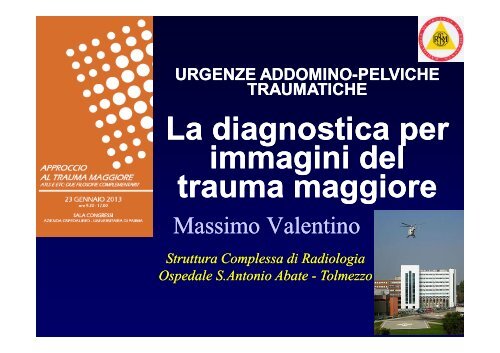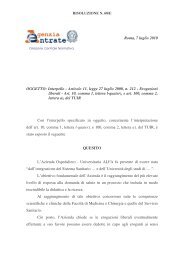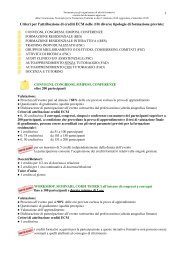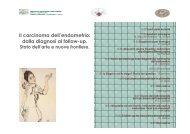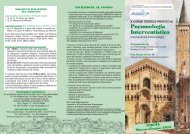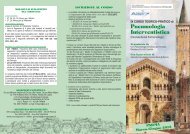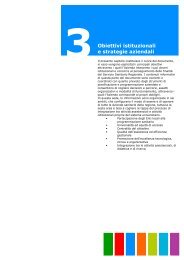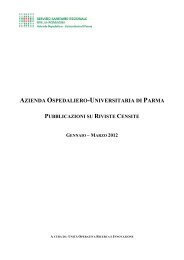La diagnostica per immagini del trauma maggiore
La diagnostica per immagini del trauma maggiore
La diagnostica per immagini del trauma maggiore
You also want an ePaper? Increase the reach of your titles
YUMPU automatically turns print PDFs into web optimized ePapers that Google loves.
URGENZE ADDOMINO<br />
ADDOMINO-PELVICHE PELVICHE<br />
TRAUMATICHE<br />
<strong>La</strong> <strong>diagnostica</strong> <strong>per</strong><br />
<strong>immagini</strong> <strong>del</strong><br />
<strong>trauma</strong> <strong>maggiore</strong><br />
Massimo Valentino<br />
Struttura Complessa di Radiologia<br />
Ospedale S.Antonio Abate - Tolmezzo
• Il <strong>trauma</strong> costituisce la prima causa di morte<br />
nel mondo occidentale <strong>per</strong> le <strong>per</strong>sone con<br />
meno di 40 anni, ed è spesso associato a<br />
disabilità e <strong>per</strong>dita di attività lavorativa<br />
• L’esame fisico è poco utile nel paziente<br />
<strong>trauma</strong>tizzato, e nel contempo una diagnosi<br />
veloce consente un trattamento rapido
Trauma <strong>maggiore</strong><br />
• <strong>La</strong> TC è la metodica gold standard <strong>per</strong> lo studio <strong>del</strong><br />
paziente <strong>trauma</strong>tizzato, <strong>per</strong> la sua abilità nel<br />
riconoscimento <strong>del</strong>le lesioni degli organi solidi e cavi<br />
e <strong>del</strong>le fratture ossee<br />
• L’imaging deve essere parte <strong>del</strong> contesto<br />
organizzativo (ATLS)<br />
• Nell’approccio al paziente <strong>trauma</strong>tizzato si deve<br />
considerare prima di tutto il mantenimento <strong>del</strong>le<br />
funzioni vitali (approccio ABCDE)
RXT<br />
Triage <strong>del</strong> Trauma<br />
FAST (E-FAST)
US NEI TRAUMI ADDOMINALI<br />
L’US consente di identificare le lesioni che necessitano di intervento<br />
chirurgico senza creare i rischi di una laparotomia non-terapeutica<br />
Acad Emerg Med 2000
FAST<br />
Focused Assessment with Sonography for Trauma<br />
6 scansioni
FAST<br />
INTERPRETAZIONE<br />
POSITIVO:<br />
- Fluido in addome, pleura o <strong>per</strong>icardio<br />
NEGATIVO:<br />
- No fluido in nessuna sede<br />
Sostituisce il lavaggio <strong>per</strong>itoneale!
Quali indicazioni?<br />
Dove?<br />
Quando?<br />
EFAST OGGI<br />
Trauma toraco toraco-addominale<br />
addominale chiuso e penetrante, stabile e instabile* instabile*.<br />
Nel “ “point point of care”: scena <strong>del</strong> <strong>trauma</strong>, trasporto, shock room room, , reparti di<br />
osservazione e terapia intensiva.<br />
Tradizionalmente alla fine <strong>del</strong>la valutazione primaria ABCDE ( (primary primary<br />
survey survey): ): E=Echography<br />
E=Echography? ? O nella valutazione secondaria.<br />
O in qualunque fase <strong>del</strong>la valutazione primaria possa aiutare nell nella a<br />
individuazione e risoluzione di qualunque problema da trattare incontr incontrato ato<br />
nelle precedenti fasi ABCD<br />
*Eccezione il <strong>trauma</strong> penetrante instabile senza rischio di tamponamento cardiaco
Parasternale<br />
dx<br />
EFAST<br />
Tecnica d’esame<br />
Procedura a 6 finestre ecografiche<br />
ecografiche:<br />
Regola mnemonica <strong>del</strong>le 10 “P”<br />
Parasternale<br />
sn<br />
Pericardica Pleurica sn<br />
4 5<br />
+<br />
Perisplenica<br />
+<br />
Paracolica sn<br />
Pleurica dx +<br />
Periepatica<br />
+<br />
Paracolica dx<br />
2<br />
3<br />
6<br />
1<br />
Pelvica
US NEI TRAUMI ADDOMINALI<br />
Despite its high specificity, US has a low sensitivity for<br />
the detection of both free fluid and organ lesions. In<br />
clinically suspected abdominal <strong>trauma</strong>, another<br />
assessment must be <strong>per</strong>formed regardless of the initial<br />
US findings (Stengel et al. Br J Surg, 2001)<br />
Ecografia con MDC <strong>per</strong> migliorare le<br />
<strong>per</strong>formance diagnostiche
Riconoscimento <strong>del</strong> “blushing”<br />
. Segno più importante nel <strong>trauma</strong><br />
• Stessa semeiotica apprezzabile con la TC
TRAUMA<br />
TCMS<br />
<strong>La</strong> TC è la metodica radiologica più veloce che <strong>per</strong>mette una completa<br />
co<strong>per</strong>tura di tutto il corpo nel Pz poli<strong>trauma</strong>tizzato entro la golden hour<br />
dopo il <strong>trauma</strong><br />
Leidner B., Emergency Radiology, 2001<br />
In generale il Pz non dovrebbe lasciare l’area di emergenza <strong>per</strong> l’esecuzione<br />
<strong>del</strong>le indagini diagnostiche. Una TC multislice dovrebbe essere collocata<br />
nell’area <strong>del</strong>le emergenze, preferibilmente nelle vicinanze <strong>del</strong>la sala o<strong>per</strong>atoria<br />
Baker S.R., Diagnostic Imaging, 2001<br />
Una TC multislice total body eseguita immediatamente dopo le procedure di<br />
rianimazione nel Pz poli<strong>trauma</strong>tizzato fornisce più informazioni di un<br />
approccio classico con TC conv, Rx e US<br />
Albrecht T. 2001 RSNA meeting
IL TRAUMA: la TCMS
Wurmb, Thomas et al Whole-Body Multislice Computed Tomography as<br />
the First Line Diagnostic Tool in Patients With Multiple Injuries: The<br />
Focus on Time. J of Trauma. 66(3):658-665, 2009.<br />
3
“Single” Acquisition MDCT<br />
Trauma Scanograms<br />
Head, C-Spine, Chest, Abdomen, Pelvis<br />
Courtesy of R. Novelline, MGH, Harward Univ, Boston
“Whole Body” CT<br />
- Eliminate rescanning for detailed exams<br />
- Thoracic and lumbar spine<br />
- CTA of aorta and great vessels<br />
- Face<br />
- Maintain quality of neck, chest, abdomen and<br />
pelvis<br />
(re)evolution in <strong>trauma</strong> philosophy
Whole Body CT TRAUMA SURVEY<br />
• Ampi volumi: rapida ed accurata<br />
• In pochi secondi, informazioni diagnostiche cruciali<br />
• Elementi di certezza <strong>per</strong> la gestione (cosa, come, quando)<br />
• Molteplici possibilità di rielaborazione nel post-processing
TCMD <strong>trauma</strong> protocol<br />
Pre Pre-contrast contrast phase<br />
Triphasic post post-contrast contrast phase<br />
L.Romano et al<br />
MDCT Technology and<br />
Applications<br />
Selected Reviews<br />
ED. Springer 2008<br />
Patient Patient position position: supine with elevated arms<br />
Scan Scan range: whole body according to scanogram<br />
Scan Scan parameters: 64-slice / SC 0.625/ axial 2.5; MPR-VR-MinMIP<br />
Bolus tracking<br />
Contrast Contrast medium medium: 400 mg/ml<br />
Contrast Contrast injection: ~120 cc c.m.+ 40 cc saline flush/ flow-rate 4-5 ml/sec
In the setting of <strong>trauma</strong>, one of the most significant<br />
advantages granted by 64-MDCT is the ability to combine<br />
what once amounted to multiple separate studies into a<br />
single, individually tailored examination.
The multistep studies stem<br />
from the initial acquisition<br />
of the CT scout image.<br />
Using the scout images,<br />
multiple, complex CT<br />
examinations are planned<br />
and combined into one<br />
scan using a single<br />
contrast injection.
Treatment actually changed in 36 of the 106 patients<br />
(34%, 95% CI 25%–43%) as a direct result of the<br />
findings by chest or abdominal CT scan.
Initial Clinical Ex<strong>per</strong>ience With a 64-MDCT Whole-Body Scanner in an Emergency Department: Better Time<br />
Management and Diagnostic Quality? Rieger, Michael et al Journal of Trauma. 66(3):648-657, March 2009.
Injury Grading Scales<br />
• Rapida comunicazione <strong>del</strong>la gravità <strong>del</strong>le<br />
lesioni<br />
• Correlazione con il trattamento<br />
• Grading TC
TRAUMI SPLENICI
TRAUMI SPLENICI<br />
• Organo più spesso sede di lesioni<br />
• TCMD - 98% accurata<br />
• Lesioni vasculari – 83%<br />
• Fratture costali 20%<br />
• Grading systems<br />
HM, KS, SEM, et al. JACS 2008 ; 206:685-93
Grade Description of Injury<br />
I Subcapsular hematoma 3 cm in diameter<br />
IVA Active intraparenchymal and subcapsular splenic bleeding<br />
Splenic vascular injury (pseudoaneurysm or arteriovenous fistula)<br />
IVB Active intra<strong>per</strong>itoneal bleeding<br />
V Shattered spleen
MDCT BASED INJURY<br />
GRADE
I GRADO
III GRADO
IV GRADO
ACTIVE BLEEDING &<br />
VASCULAR LESIONS<br />
Area irregolare o lineare<br />
Incrementa in fase tardiva<br />
Pseudoaneurismi<br />
Fistola Artero-venosa<br />
Embolizzazione nel 94%
TRAUMI EPATICI
Correlazione chirurgia - TC <strong>del</strong> danno epatico<br />
1. <strong>La</strong>cerazione capsulare, lacerazione su<strong>per</strong>ficiale, ematoma<br />
subcapsulare < 1cm, ipodensità <strong>per</strong>iportale<br />
2. <strong>La</strong>cerazione , ematoma subcapsulare o parenchimale di 1-3cm<br />
3. <strong>La</strong>cerazione , ematoma subcapsulare o parenchimale > 3cm<br />
4. Ematoma subcapsulare o parenchimale > 10 cm; distruzione o<br />
devascolarizzazione lobare<br />
5. Distruzione o devascolarizzazione bilobare
Correlazione chirurgia - TC <strong>del</strong> danno epatico<br />
1. <strong>La</strong>cerazione capsulare, lacerazione su<strong>per</strong>ficiale, ematoma<br />
subcapsulare < 1cm, ipodensità <strong>per</strong>iportale<br />
2. <strong>La</strong>cerazione , ematoma subcapsulare o parenchimale di 1-3cm<br />
3. <strong>La</strong>cerazione , ematoma subcapsulare o parenchimale > 3cm<br />
Trattamento conservativo anche in presenza di lesioni complesse<br />
ed estese, associate a cospicuo emo<strong>per</strong>itoneo, in paziente<br />
emodinamicamente stabile<br />
Radiology 1987; 164: 635-638<br />
Br J Surg 2000; 87: 1732
Correlazione chirurgia - TC <strong>del</strong> danno epatico<br />
4. Ematoma subcapsulare o parenchimale > 10 cm; distruzione o<br />
devascolarizzazione lobare<br />
5. Distruzione o devascolarizzazione bilobare<br />
Alta frequenza di lesione vascolare<br />
-Arteriosa (Angiografia) Embolizzazione o Celiotomia<br />
-Venosa Trattamento chirurgico<br />
Radiology 2000; 216: 418-427
TC multidetettore: Lesioni elementari<br />
Grado 2 <strong>La</strong>cerazione, ematoma subcapsulare o parenchimale<br />
di 1-3 cm
TC multidetettore: Lesioni elementari<br />
Grado 3 <strong>La</strong>cerazione, ematoma subcapsulare o parenchimale > 3 cm
TC multidetettore: Lesioni elementari<br />
Grado 4<br />
Ematoma subcapsulare o parenchimale > 10 cm;<br />
distruzione o devascolarizzazione lobare
TC multidetettore: Lesioni elementari<br />
Grado 5 Distruzione o devascolarizzazione bilobare
Traumi <strong>del</strong> pancreas – Classificazione TC<br />
I: contusione o lacerazione intracapsulare senza<br />
lesione duttale<br />
II: frattura distale o lesione parenchimale con lesione<br />
duttale<br />
III: frattura prossimale o lesione parenchimale con<br />
lesione duttale<br />
IV: lesione pancreatica + lesione duodenale o<br />
ampollare, lesione comminuta o avulsione bilioduodenale<br />
Arkovitz MS, J Trauma 1997
Contusione <strong>del</strong>la coda <strong>del</strong><br />
pancreas<br />
<strong>La</strong>cerazione <strong>del</strong>la milza<br />
Rottura <strong>del</strong> diaframma<br />
Contusione <strong>del</strong> rene
Grado II<br />
Transezione <strong>del</strong>la coda<br />
<strong>del</strong> pancreas
Frattura comminuta<br />
<strong>del</strong>la coda <strong>del</strong><br />
pancreas, con<br />
esteso ematoma e<br />
sanguinamento<br />
attivo<br />
Grado IV
TRAUMI DEL RENE<br />
• Tipo I: più frequente (75-85%), lesioni<br />
lievi <strong>del</strong> parenchima e/o <strong>del</strong>la capsula<br />
• Tipo II: 10%, lacerazioni più gravi<br />
• Tipo III: 5%, lesioni molto gravi con<br />
lacerazioni multiple<br />
• Tipo IV: 1-2% avulsione <strong>del</strong> giunto<br />
pielo-ureterale da brusca<br />
decelerazione, 3% trombosi arteriosa<br />
da investimento o da caduta dall’alto
ROTTURA RENALE DI II TIPO E<br />
SPLENICA CON PSEUDOANEURISMA
FRATTURA RENALE: III TIPO
DISSEZIONE POST-TRAUMATICA<br />
DELL’A. RENALE: IV TIPO
ROTTURA DEL GIUNTO P-U: IV TIPO
FRATTURE <strong>del</strong> CINGOLO<br />
PELVICO<br />
• Correlati ad una significativa morbilità e<br />
mortalità<br />
• Importante problema diagnostico poiché il<br />
danno alle strutture vascolari assume spesso<br />
un significato clinico <strong>maggiore</strong> rispetto al<br />
danno scheletrico<br />
Pinto et al, Radiol med<br />
(2010) 115:648–667
Classificazione<br />
Young e Burgess: “Stability can be judget by fracture pattern, direction<br />
of the force of injury, and the knowledge of pelvic legamentous pattern”<br />
• Compressione antero - posteriore (APC)<br />
• Compressione laterale (LC)<br />
• Taglio verticale (VS)<br />
• Vettori di forza combinati (CM)<br />
... “Provides guidance for the management in the emergency room”...<br />
…”High index of suspicion is essential for diagnosis when patient is unconscious”…
TC: COMPRESSIONE A-P
TC: COMPRESSIONE LATERALE (LC)
FORZE COMPLESSE (CM)<br />
Frequenza 14% - Instabili - Frequenti complianze vascolari e/o viscerali<br />
Azione contemporanea e combinazione di vettori di forza diversi
Take home points<br />
• <strong>La</strong> <strong>diagnostica</strong> <strong>per</strong> <strong>immagini</strong> è parte<br />
<strong>del</strong> work flow nel <strong>trauma</strong><br />
(RX/US/CEUS)<br />
• <strong>La</strong> TCMS è la guida <strong>del</strong> trattamento<br />
• Massima attenzione nell’identificare<br />
le lesioni vascolari


